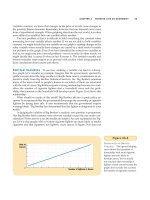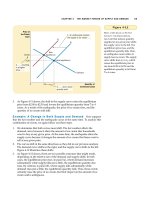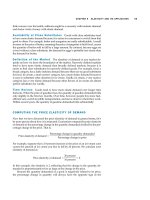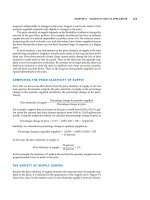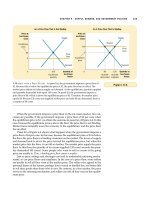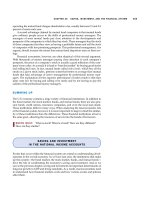Tài liệu Ten Principles of Economics - Part 13 doc
Bạn đang xem bản rút gọn của tài liệu. Xem và tải ngay bản đầy đủ của tài liệu tại đây (198.63 KB, 10 trang )
CHAPTER 6 SUPPLY, DEMAND, AND GOVERNMENT POLICIES 125
When the government imposes a price floor on the ice-cream market, two out-
comes are possible. If the government imposes a price floor of $2 per cone when
the equilibrium price is $3, we obtain the outcome in panel (a) of Figure 6-4. In this
case, because the equilibrium price is above the floor, the price floor is not binding.
Market forces naturally move the economy to the equilibrium, and the price floor
has no effect.
Panel (b) of Figure 6-4 shows what happens when the government imposes a
price floor of $4 per cone. In this case, because the equilibrium price of $3 is below
the floor, the price floor is a binding constraint on the market. The forces of supply
and demand tend to move the price toward the equilibrium price, but when the
market price hits the floor, it can fall no further. The market price equals the price
floor. At this floor, the quantity of ice cream supplied (120 cones) exceeds the quan-
tity demanded (80 cones). Some people who want to sell ice cream at the going
price are unable to. Thus, a binding price floor causes a surplus.
Just as price ceilings and shortages can lead to undesirable rationing mecha-
nisms, so can price floors and surpluses. In the case of a price floor, some sellers
are unable to sell all they want at the market price. The sellers who appeal to the
personal biases of the buyers, perhaps due to racial or familial ties, are better able
to sell their goods than those who do not. By contrast, in a free market, the price
serves as the rationing mechanism, and sellers can sell all they want at the equilib-
rium price.
(a) A Price Floor That Is Not Binding
$3
2
Quantity of
Ice-Cream
Cones
0
Price of
Ice-Cream
Cone
100
Equilibrium
quantity
(b) A Price Floor That Is Binding
$4
Quantity of
Ice-Cream
Cones
0
Price of
Ice-Cream
Cone
3
Price
floor
Demand
Supply
Price
floor
80
Quantity
demanded
120
Quantity
supplied
Equilibrium
price
Equilibrium
price
Demand
Supply
Surplus
Figure 6-4
AM
ARKET WITH A
P
RICE
F
LOOR
. In panel (a), the government imposes a price floor of
$2. Because this is below the equilibrium price of $3, the price floor has no effect. The
market price adjusts to balance supply and demand. At the equilibrium, quantity supplied
and quantity demanded both equal 100 cones. In panel (b), the government imposes a
price floor of $4, which is above the equilibrium price of $3. Therefore, the market price
equals $4. Because 120 cones are supplied at this price and only 80 are demanded, there is
a surplus of 40 cones.
126 PART TWO SUPPLY AND DEMAND I: HOW MARKETS WORK
CASE STUDY
THE MINIMUM WAGE
An important example of a price floor is the minimum wage. Minimum-wage
laws dictate the lowest price for labor that any employer may pay. The U.S.
Congress first instituted a minimum wage with the Fair Labor Standards Act of
1938 to ensure workers a minimally adequate standard of living. In 1999 the
minimum wage according to federal law was $5.15 per hour, and some state
laws imposed higher minimum wages.
To examine the effects of a minimum wage, we must consider the mar-
ket for labor. Panel (a) of Figure 6-5 shows the labor market which, like all
markets, is subject to the forces of supply and demand. Workers determine
the supply of labor, and firms determine the demand. If the government
doesn’t intervene, the wage normally adjusts to balance labor supply and
labor demand.
Panel (b) of Figure 6-5 shows the labor market with a minimum wage. If the
minimum wage is above the equilibrium level, as it is here, the quantity of labor
supplied exceeds the quantity demanded. The result is unemployment. Thus,
the minimum wage raises the incomes of those workers who have jobs, but it
lowers the incomes of those workers who cannot find jobs.
To fully understand the minimum wage, keep in mind that the economy
contains not a single labor market, but many labor markets for different types of
workers. The impact of the minimum wage depends on the skill and experience
of the worker. Workers with high skills and much experience are not affected,
because their equilibrium wages are well above the minimum. For these work-
ers, the minimum wage is not binding.
(a) A Free Labor Market
Quantity of
Labor
0
Wage
Equilibrium
employment
(b) A Labor Market with a Binding Minimum Wage
Quantity of
Labor
0
Wage
Quantity
demanded
Quantity
supplied
Labor
supply
Labor
demand
Minimum
wage
Labor surplus
(unemployment)
Equilibrium
wage
Labor
demand
Labor
supply
Figure 6-5
H
OW THE
M
INIMUM
W
AGE
A
FFECTS THE
L
ABOR
M
ARKET
. Panel (a) shows a labor
market in which the wage adjusts to balance labor supply and labor demand. Panel (b)
shows the impact of a binding minimum wage. Because the minimum wage is a price
floor, it causes a surplus: The quantity of labor supplied exceeds the quantity demanded.
The result is unemployment.
CHAPTER 6 SUPPLY, DEMAND, AND GOVERNMENT POLICIES 127
The minimum wage has its greatest impact on the market for teenage labor.
The equilibrium wages of teenagers are low because teenagers are among the
least skilled and least experienced members of the labor force. In addition,
teenagers are often willing to accept a lower wage in exchange for on-the-job
training. (Some teenagers are willing to work as “interns” for no pay at all. Be-
cause internships pay nothing, however, the minimum wage does not apply to
them. If it did, these jobs might not exist.) As a result, the minimum wage is
more often binding for teenagers than for other members of the labor force.
Many economists have studied how minimum-wage laws affect the teenage
labor market. These researchers compare the changes in the minimum wage over
time with the changes in teenage employment. Although there is some debate
about how much the minimum wage affects employment, the typical study finds
that a 10 percent increase in the minimum wage depresses teenage employment
between 1 and 3 percent. In interpreting this estimate, note that a 10 percent in-
crease in the minimum wage does not raise the average wage of teenagers by 10
percent. A change in the law does not directly affect those teenagers who are al-
ready paid well above the minimum, and enforcement of minimum-wage laws is
not perfect. Thus, the estimated drop in employment of 1 to 3 percent is significant.
In addition to altering the quantity of labor demanded, the minimum wage
also alters the quantity supplied. Because the minimum wage raises the wage
that teenagers can earn, it increases the number of teenagers who choose to look
for jobs. Studies have found that a higher minimum wage influences which
teenagers are employed. When the minimum wage rises, some teenagers who
are still attending school choose to drop out and take jobs. These new dropouts
displace other teenagers who had already dropped out of school and who now
become unemployed.
The minimum wage is a frequent topic of political debate. Advocates of the
minimum wage view the policy as one way to raise the income of the working
poor. They correctly point out that workers who earn the minimum wage can
afford only a meager standard of living. In 1999, for instance, when the mini-
mum wage was $5.15 per hour, two adults working 40 hours a week for every
week of the year at minimum-wage jobs had a total annual income of only
$21,424, which was less than half of the median family income. Many advocates
of the minimum wage admit that it has some adverse effects, including unem-
ployment, but they believe that these effects are small and that, all things con-
sidered, a higher minimum wage makes the poor better off.
Opponents of the minimum wage contend that it is not the best way to
combat poverty. They note that a high minimum wage causes unemployment,
encourages teenagers to drop out of school, and prevents some unskilled work-
ers from getting the on-the-job training they need. Moreover, opponents of the
minimum wage point out that the minimum wage is a poorly targeted policy.
Not all minimum-wage workers are heads of households trying to help their
families escape poverty. In fact, fewer than a third of minimum-wage earners
are in families with incomes below the poverty line. Many are teenagers from
middle-class homes working at part-time jobs for extra spending money.
EVALUATING PRICE CONTROLS
One of the Ten Principles of Economics discussed in Chapter 1 is that markets are
usually a good way to organize economic activity. This principle explains why
128 PART TWO SUPPLY AND DEMAND I: HOW MARKETS WORK
economists usually oppose price ceilings and price floors. To economists, prices are
not the outcome of some haphazard process. Prices, they contend, are the result of the
millions of business and consumer decisions that lie behind the supply and demand
curves. Prices have the crucial job of balancing supply and demand and, thereby, co-
ordinating economic activity. When policymakers set prices by legal decree, they ob-
scure the signals that normally guide the allocation of society’s resources.
Another one of the Ten Principles of Economics is that governments can some-
times improve market outcomes. Indeed, policymakers are led to control prices be-
cause they view the market’s outcome as unfair. Price controls are often aimed at
helping the poor. For instance, rent-control laws try to make housing affordable for
everyone, and minimum-wage laws try to help people escape poverty.
Yet price controls often hurt those they are trying to help. Rent control may
keep rents low, but it also discourages landlords from maintaining their buildings
and makes housing hard to find. Minimum-wage laws may raise the incomes of
some workers, but they also cause other workers to be unemployed.
Helping those in need can be accomplished in ways other than controlling prices.
For instance, the government can make housing more affordable by paying a fraction
of the rent for poor families. Unlike rent control, such rent subsidies do not reduce the
quantity of housing supplied and, therefore, do not lead to housing shortages. Simi-
larly, wage subsidies raise the living standards of the working poor without discour-
aging firms from hiring them. An example of a wage subsidy is the earned income tax
credit, a government program that supplements the incomes of low-wage workers.
Although these alternative policies are often better than price controls, they are
not perfect. Rent and wage subsidies cost the government money and, therefore,
require higher taxes. As we see in the next section, taxation has costs of its own.
QUICK QUIZ: Define price ceiling and price floor, and give an example of
each. Which leads to a shortage? Which leads to a surplus? Why?
TAXES
All governments—from the federal government in Washington, D.C., to the local
governments in small towns—use taxes to raise revenue for public projects, such
as roads, schools, and national defense. Because taxes are such an important pol-
icy instrument, and because they affect our lives in many ways, the study of taxes
is a topic to which we return several times throughout this book. In this section we
begin our study of how taxes affect the economy.
To set the stage for our analysis, imagine that a local government decides to
hold an annual ice-cream celebration—with a parade, fireworks, and speeches by
town officials. To raise revenue to pay for the event, it decides to place a $0.50 tax
on the sale of ice-cream cones. When the plan is announced, our two lobbying
groups swing into action. The National Organization of Ice Cream Makers claims
that its members are struggling to survive in a competitive market, and it argues
that buyers of ice cream should have to pay the tax. The American Association of
Ice Cream Eaters claims that consumers of ice cream are having trouble making
ends meet, and it argues that sellers of ice cream should pay the tax. The town
mayor, hoping to reach a compromise, suggests that half the tax be paid by the
buyers and half be paid by the sellers.
CHAPTER 6 SUPPLY, DEMAND, AND GOVERNMENT POLICIES 129
To analyze these proposals, we need to address a simple but subtle question:
When the government levies a tax on a good, who bears the burden of the tax? The
people buying the good? The people selling the good? Or, if buyers and sellers
share the tax burden, what determines how the burden is divided? Can the gov-
ernment simply legislate the division of the burden, as the mayor is suggesting, or
is the division determined by more fundamental forces in the economy? Econo-
mists use the term tax incidence to refer to these questions about the distribution
of a tax burden. As we will see, we can learn some surprising lessons about tax in-
cidence just by applying the tools of supply and demand.
HOW TAXES ON BUYERS AFFECT MARKET OUTCOMES
We first consider a tax levied on buyers of a good. Suppose, for instance, that our
local government passes a law requiring buyers of ice-cream cones to send $0.50 to
the government for each ice-cream cone they buy. How does this law affect the
buyers and sellers of ice cream? To answer this question, we can follow the three
steps in Chapter 4 for analyzing supply and demand: (1) We decide whether the
law affects the supply curve or demand curve. (2) We decide which way the curve
shifts. (3) We examine how the shift affects the equilibrium.
The initial impact of the tax is on the demand for ice cream. The supply curve
is not affected because, for any given price of ice cream, sellers have the same in-
centive to provide ice cream to the market. By contrast, buyers now have to pay a
tax to the government (as well as the price to the sellers) whenever they buy ice
cream. Thus, the tax shifts the demand curve for ice cream.
The direction of the shift is easy to determine. Because the tax on buyers
makes buying ice cream less attractive, buyers demand a smaller quantity of ice
cream at every price. As a result, the demand curve shifts to the left (or, equiva-
lently, downward), as shown in Figure 6-6.
tax incidence
the study of who bears the burden
of taxation
$3.30
3.00
2.80
Quantity of
Ice-Cream Cones
0
Price of
Ice-Cream
Cone
Price
without
tax
Price
sellers
receive
10090
Equilibrium
with tax
Equilibrium without tax
Tax ($0.50)
Price
buyers
pay
D
1
D
2
Supply,
S
1
A tax on buyers
shifts the demand
curve downward
by the size of
the tax ($0.50).
Figure 6-6
AT
AX ON
B
UYERS
. When a tax
of $0.50 is levied on buyers, the
demand curve shifts down by
$0.50 from D
1
to D
2
. The
equilibrium quantity falls from
100 to 90 cones. The price that
sellers receive falls from $3.00 to
$2.80. The price that buyers pay
(including the tax) rises from
$3.00 to $3.30. Even though the
tax is levied on buyers, buyers
and sellers share the burden of
the tax.
